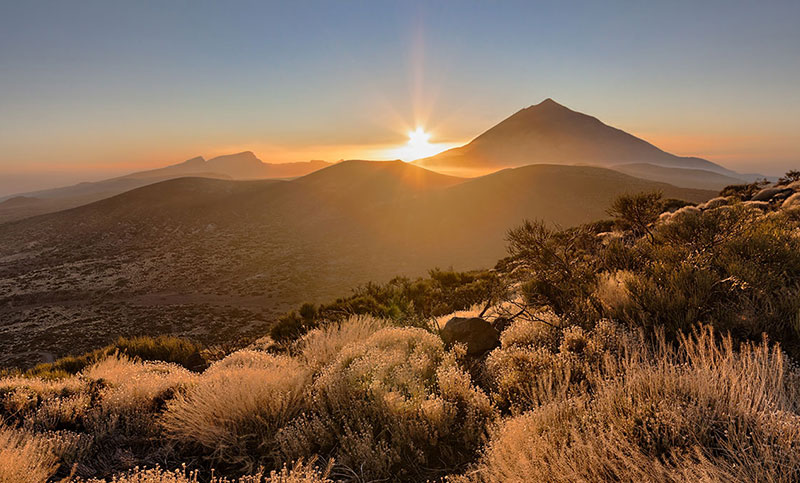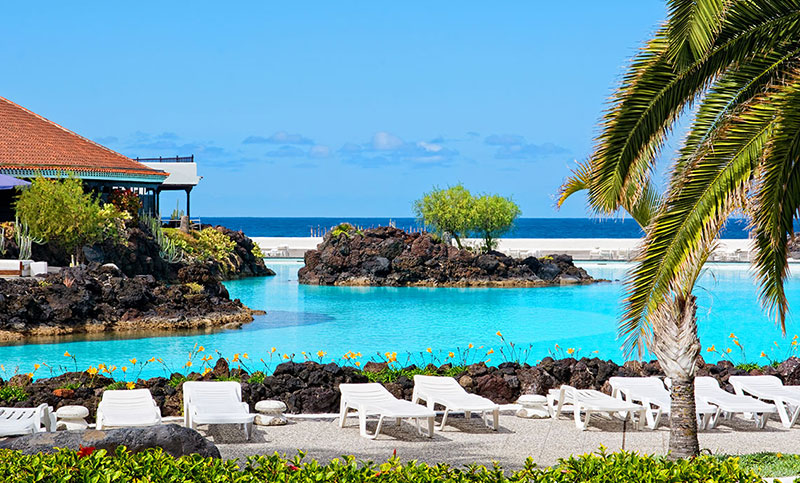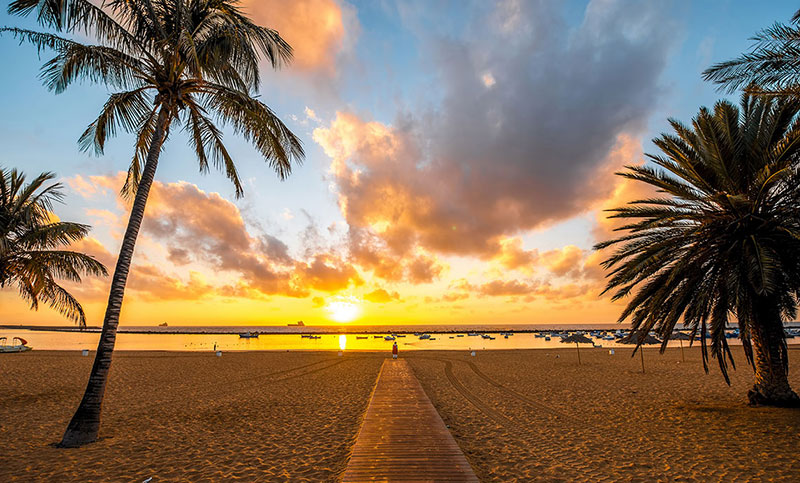What to see in tenerife north indispensable places
THERE IS A LOT TO SEE IN TENERIFE NORTE, BUT WE SELECTED FOR YOU WHAT YOU SHOULD NOT MISS.
The north of the island of Tenerife is very different from the south, it has greener areas, with dense elevations and ravines, and coasts of black sand and callao stones. If you want to have a real vision of the island when you travel to Tenerife, we propose you to jump to both areas.
It is worthwhile to organize your trip to Tenerife including historical centers, natural areas of coast and mountains, trails and the National Park, and places that are gastronomic references.

Valle de La Orotava
CHARMING VILLAGES
Let’s start by visiting the most striking towns in the northern area.
La Orotava Valley
This Valley is made up of three municipalities: La Orotava, Los Realejos and Puerto de la Cruz, each with different charms. We suggest that you go up to La Orotava and walk through the streets of the centre, as they are a perfect approach to tradition and traditional culture.
In La Orotava, you can walk through cobbled streets, observe houses from the 16th and 17th centuries full of history, such as La Casa de Los Balcones or La Casa Lercaro. You can go to the traditional gofio mill La Máquina, where gofio has been prepared for over 100 years, one of the most characteristic foods of the Canary Islands.
La Orotava is a city that has joined the Slow movement, and proposes a relaxed tourism that approaches the traditions and real folklore of Tenerife.
Puerto de la Cruz is the coastal municipality par excellence within the Valley. This small town of coastal origin was one of the first tourist towns in the archipelago, and maintains a balance between the conservation of tradition and the offer of services focused on tourism. Many charming places are concentrated around its coastal pier, such as: Plaza del Charco, Casa de La Aduana, Plaza de la Iglesia or Punta del Viento. Spend a few hours discovering Puerto Street Art, a list of murals by international authors that are located outdoors.
Los Realejos is a municipality that hides pleasant surprises, such as the spectacular viewpoint of San Pedro and the Ramba de Castro, a simple path that helps you walk along the north coast and enjoy amazing landscapes.
The Lagoon
The municipality of San Cristóbal de La Laguna was declared a World Heritage Site by UNESCO in 1999. This distinction is given because it is a unique example of an unwalled colonial city. Its streets are an example of traditional Canarian architecture, with comfortable areas for walking.
We suggest that you take a walk along Herradores Street and Obispo Rey Redondo Street, visit the Cathedral and the Church of the Conception and jump to the Museum of History and Anthropology of Tenerife, which is divided between the Casa de Carta and the Casa Lercaro.
Icod de Los Vinos
This municipality has similar characteristics to La Orotava, it still preserves cobbled streets and it is home to the Drago Milenario, a tree linked to numerous legends of the Guanche population, the natives of the islands.
Visiting the Drago Park is a certain one, both for the contact with the tradition of the island and for the beauty of this municipality.
Garachico
This municipality with a lot of history, in front of its coasts is the Roque de Garachico, this small islet rises in front of the coast and is the habitat of threatened species like the small shearwater.
The port of Garachico was an important enclave in the trade of goods, such as bananas and other crops. Near the old dock are the natural pools of El Caletón, a very particular space in front of which to enjoy a drink or a meal.
It is very easy to walk around the historical centre of Garachico, its pedestrian streets and its few slopes are very comfortable for any kind of tourist.

Charlo La Laja
CHARMING BEACHES
You can’t visit Tenerife and overlook its beaches and puddles. In the northern area you will find beaches with callaos and black sand, and numerous puddles or natural pools very typical and particular.
Bollullo Beach
Bollullo Beach, in the municipality of La Orotava, is an example of a typical beach in the north of Tenerife. Its sand is black, and offers a great contrast to the blue of the sea and the blue of the sky. This beach is located between cuts and elevations of land, which makes it a special place and little saturated.
Access to this point is via a path of steps, and on the beach itself you will find a bar where you can refresh yourself or taste some typical local products.
We recommend that you be especially careful with the waves on this beach.
Jardin Beach
This complex of three consecutive beaches, is located in Puerto de la Cruz, and from the sand of any of them you can enjoy great views of the Teide volcano.
These beaches have lifeguards, and hotel services, as well as showers and toilets.
Its access is very simple, and it has the style of an urban beach but without big overcrowding.
It is common in winter for people to enjoy a swim in front of the sight of snowy Teide.
El Caletón
The natural pools of El Caletón, in Garachico, are a unique enclave. The morphology of the lava cooling from the eruption of the Arenas Negras volcano has been used to adapt it to the bath with multiple accesses and stairs.
In these pools you will be able to observe numerous fish and crabs, which are at their leisure in this natural space.
Charco de La Araña, Charco Don Gabino and Charco Los Chochos
In the municipality of Los Silos, there is a promenade dotted with puddles ideal for bathing. You can choose the puddle that best suits your needs.
El Charco de La Araña is a natural pool that only emerges when the sea is low, and offers crystal-clear bottoms, ideal for snorkeling. Next to this pool is the Charco Los Chochos, another rock formation where you can swim in comfort. It is ideal for families and has easy access by a stone staircase.
El Charco Don Gabino is another pool of similar characteristics, but has a larger area of solarium to enjoy lying in the sun. It is recommended prudence when approaching the zone more next to the sea, by its strong surge.
From this area you can enjoy beautiful views of the La Culata cliffs.
As a curiosity, on this promenade you will find the skeleton of a Sei whale, a whale of about 16 meters, exposed in the open air.
Puddle of the Wind
El Charco del Viento is located in the municipality of La Guancha, and has easy access and ample parking. It is a space suitable for swimming, fishing and snorkeling. Its crystalline waters make it a beautiful enclave.
The arms of lava that go into the sea protect the bathing area from high waves, so it is common to find calm waters.

Parque Nacional del Teide
NATURAL AREAS
The inland areas of the north of the island are unique and easily visited.
Teide National Park
Teide National Park is one of the main symbols of the island, especially Teide, the volcano that has the merit of being the highest peak in Spain. This natural space was declared a World Heritage Site by UNESCO in 2007, in the category of Natural Heritage.
The extension of the park reaches almost 19,000 hectares, full of surprising volcanic landscapes that go from malpaises to plains and rocks.
If you want to access the highest point of the Teide, you will have to obtain a special permit, because it has been limited to preserve the area.
You can speed up the climb to the peak with the Cable Car, and complete the rest of the ascent on foot.
You can also complete different routes and trails through other areas of the Park, such as the 7 Glens route, which starts at the Portillo Visitor Center and ends at the Cañada Blanca Visitor Center.
Any trail you choose in the National Park will offer you spectacular landscapes.
We recommend that on the road ascent from the northern area to the National Park, you make several stops at the signposted viewpoints and sidings so that you can enjoy the landscape. You can even discover the visual effect of the sea of clouds.
Anaga Rural Park
The Anaga Rural Park is located very close to the capital, Santa Cruz de Tenerife. This territory declared a Biosphere Reserve, has steep peaks and deep valleys and ravines.
This park has a wide network of trails of different lengths and difficulty, so you will easily find trails adapted to your physical shape and interests. Some of them even go down to small coves, and you can do them on foot, by mountain bike, on horseback, etc.
The Cave of the Wind
The Cueva del Viento is a network of volcanic tubes found in Icod de Los Vinos. This space was formed more than 27,000 years ago from basaltic lava from the Pico Viejo volcano.
This volcanic tube is the fifth longest in the world, 18 kilometers that are organized in a network of underground labyrinths, with areas still unexplored.
They are visited with guides, who explain the geomorphological and biological particularities of this space.
The purchase of tickets for access to La Cueva del Viento must be made in advance online. This space cannot be accessed by children under 5 years of age.
Chinyero
The Chinyero Natural Reserve allows walking routes between the municipalities of Santiago del Teide, El Tanque and Garachico. There are different accesses and starting points, but no matter what you choose you will be able to walk through a volcanic landscape, with areas of lava flows, sand and volcanic bombs, pyroclasts and the Chinyero volcano itself.

Piedra de la Rosa
VIEWERS
The northern zone is populated with dreamy viewpoints, which present the landscape like a postcard.
Viewpoint of La Garañona
The Mirador de La Garañona is located in the centre of El Sauzal, and is very easy to access. From this point, you can see the cliffs of the Acentejo area and La Garañona beach. In this viewpoint, you can enjoy ice cream, sweets or coffee.
Mirador Piedra de la Rosa
If you plan to access the Teide National Park by the La Orotava road, don’t miss the opportunity to stop at a very unique viewpoint, where you have access to incredible views of the Teide and La Palma, and on the opposite side of the road, you will find a stone formation known as La Rosa or La Margarita, because of its resemblance to these flowers.
Garden Viewpoint
Located just at the beginning of the Anaga Rural Park, this viewpoint will have exceptional views of the city of La Laguna, and on very clear days you can even see the Teide.
Viewpoint of Ortuño
If you go up to El Teide, on the road to La Esperanza, you have a chance to stop at the Mirador de Ortuño, in La Victoria de Acentejo. From this point of the island you will be able to see views of the Teide National Park, and on clear days you will even be able to see the profile of the island of La Palma.

Lago Martiánez
LEISURE AND ADVENTURE SPORTS
Lake Martiánez
This swimming pool complex was designed by César Manrique, and is a space to relax, enjoy the pleasant temperature of the north of Tenerife and swim in different saltwater pools, both for children and adults.
Paragliding
Paragliding is a great option to see Tenerife Norte from an unusual point of view. One of the usual paragliding take-off areas is in La Corona, in Los Realejos. From here you can fly over the Valle de La Orotava
GASTRONOMY AND WINERIES
Wineries
Tenerife is an island traditionally linked to wine production. There are different denominations of origin in the northern part, specialized in different varieties of grapes according to the area.
Visit wineries to learn about the tradition of wine cultivation and production, and taste the variants of rosé, white and red.
We recommend a visit and tasting at Bodegas Monje, where you can also enjoy some outstanding dishes of Canarian gastronomy.
If you want to travel all over the northern side of the island of Tenerife, mobility by car allows you a great freedom of movement and will fit better to your times, and your planning.


